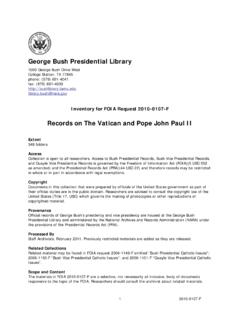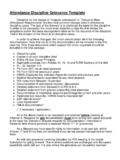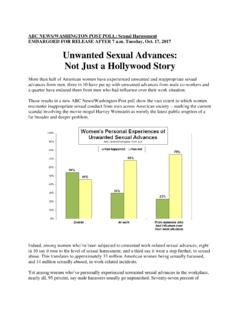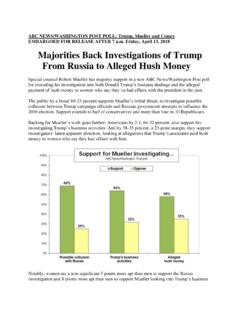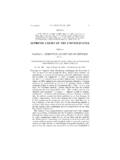Transcription of The Decennial Pattern, the Presidential Cycle, Four …
1 1 The Decennial Pattern, the Presidential cycle , Four- year Lows, and How They Affect the Stock Market Outlook for 2010 Since this is the start of the first year of a new decade it seemed like a good idea to examine a largely forgotten but useful concept known as the Decennial cycle . As we delved deeper into this task and took into consideration the fact that 2010 is a 4-year cycle low and the second (most bearish) year of the Presidential cycle , it became apparent that this year could be quite a challenging one for the equity market. Bearing in mind there is usually a happy ending to all this, l et s consider each of these concepts in turn.
2 The Decennial cycle The Decennial pattern was first noted by Edgar Lawrence Smith, who in 1939 published a book called Tides and the Affairs of His previous work, Common Stocks as a Long Term Investment, had been a best-seller in the late Smith researched equity prices back to 1880 and came to the conclusion that a 10-year pattern, or cycle , of stock price movements had more or less reproduced itself over that 58-year period. He professed no knowledge as to why the 10-year pattern seemed to recur, although he was later able to correlate the Decennial stock pat-terns with rainfall and temperature differentials in Common Stocks and Business Cycles.
3 Even though the cycle has been relatively reliable there has been to date no rational explanation as to why it works . Smith used the final digit of each year's date to identify the year in his calculations. He termed the years 1881, 1891, 1901, etc., as the first years; 1882, 1892, etc. are the second; and so forth. Inspired by the research of Dr. Elsworth Huntington and Stanley Jevons, who both emphasized the 9- to 10-year periods of recurrence in natural phenomena, Smith experimented by cutting a stock market chart into 10-year segments and placing them above each other for comparison.
4 These various decades are displayed individually in Appendix A. A secular bull trend is one in which stock prices experience a persistent up trend over the course of several 2 business cycles. A secular bear is the opposite, although some become trading ranges as opposed to an actual bear market. Chart 1shows three series, those averaged for decades in which there was a secular bull market ( s), those that developed under the cloud of a secular bear ( s), and an average of all decades since 1900. Chart 1 The green (secular bull) and the red (secular bear) contain different decades yet their trajectories are not that dissimilar.
5 The pattern observed by Smith early in the twentieth century has not changed much since then. It still appears that a typical decade consists of three cycles, each lasting approximately 40 months. The 52-week ROC of the average Decennial pattern (Chart 2) brings this cyclic rhythm out well, with lows generally appearing in years two, four and seven/early eight and highs in three, six and nine. In this exercise the year ending in zero is regarded as the tenth year. 3 The 2000 s vs. the Average Decennial cycle Charts 2 and 3 compare the latest decade with the average. In Chart 2 this is the average of all decades, while Chart 3 represents the average of all decades that developed in a secular bear market environment.
6 You can also see that this is not a perfect science because the ROC for the 2000/09 decade in Chart 2 fails abysmally to follow the idealized average pattern except for early decade weakness and the mid 2007 peak. Going into 2010 however, the ROC is consistent with an overbought condition at a reading of +25%. That does not forecast a decline into 2010 but definitely places the market in a more vulnerable situation than if the reading was below zero. Chart 2 4 Chart 3 For example in 1949, the ROC was very oversold and was inconsistent with its normal position in the Decennial pattern.
7 Instead of declining into 1950, the market actually rose. This experience is a good example of why the Decennial approach should be used with other technical indicators and not in isolation. Perhaps of greater importance is the fact that the market at the close of 1949 represented excellent value in terms of dividend yield and P/E ratio and had just emerged from a recession. There really was only one way it could go! Chart 3 highlights those turning points where the 2000/09 decade developed in sympathy with the average. This series certainly cannot be used as a precise timing device because it indicated strength between mid 2008 into early 2009, whereas the actual experience was extreme weakness.
8 That s why any study such this cannot be carelessly extrapolated but must be used in conjunction with many other indicators. 5 Years Ending in Zero According to Smith s analysis years ending in a seven were the worst with the fifth being the best performer. However, it could be argued, based on the consistency of losses, that years ending in zero are even more challenging. Appendix B shows the weekly path of the Dow for all zero years since, where we see four up and seven down. Chart 4 The character of the year depends a lot on whether it takes place during a secular bull or bear market. Up until late August there is not much difference in terms of the wave patterns .
9 6 After that a late year-end rally lifts the secular bull average to a positive return, but pushes the average secular bear to an even worse performance. One consistent characteristic is that after a weakfish opening and subsequent rally the late March/April period ushers in a universally negative environment. Table 1 sets this out quite clearly because every year experiences a mid-summer low below that of the January opening price. The average decline was a stunning 14%. The average loss at the mid-year lows was actually greater than that at year-end because of the strong the upward bias from September onwards in secular bullish years as well as strong year end rallies in 1970 and 1980.
10 Year Open Close Mid yr Low Date Year Loss Mid Year Loss 1900 21-Jun -20 1910 22-Jul 1920 27-May 1930 20-Jun 1940 132 24-Jun 1950 11-Jul 1960 28-Apr 1970 22-May 1980 964 759 21-Apr 1990 2810 2634 2645 27-Apr 2000 11357 10787 9811 14-Mar Average Table 1 Smith never offered a rationale as to why years ending in a zero were so weak. However, with the benefit of hindsight it is apparent that most of these instances have been associated with recessions. Specifically these were 1900, 1910, 1920, 1930, 1960, 1970, 1980 and year 2000 was not a recession one but led the 2001 downturn.

